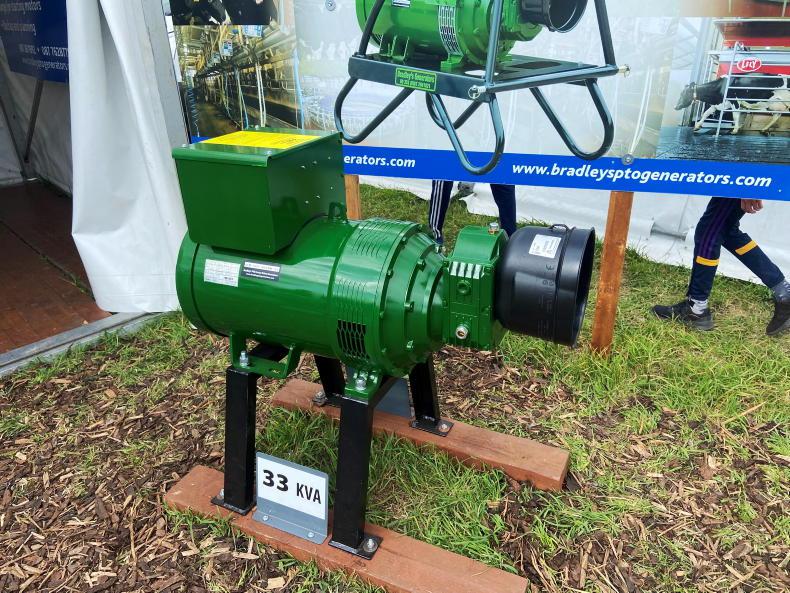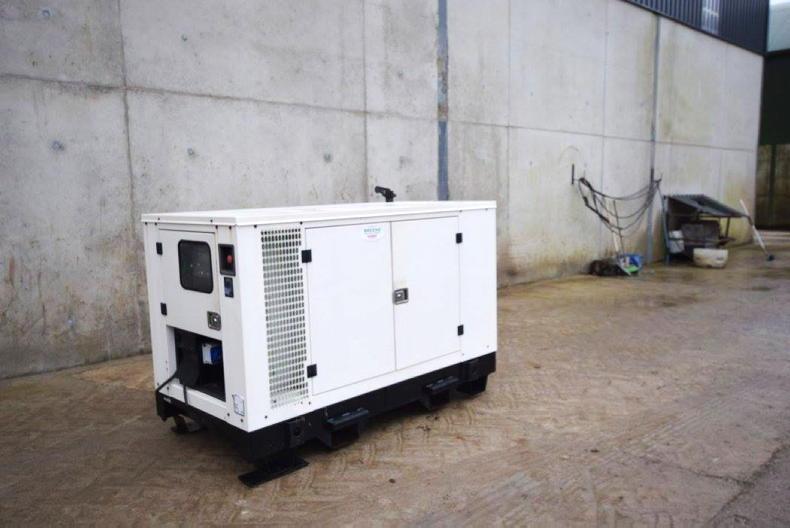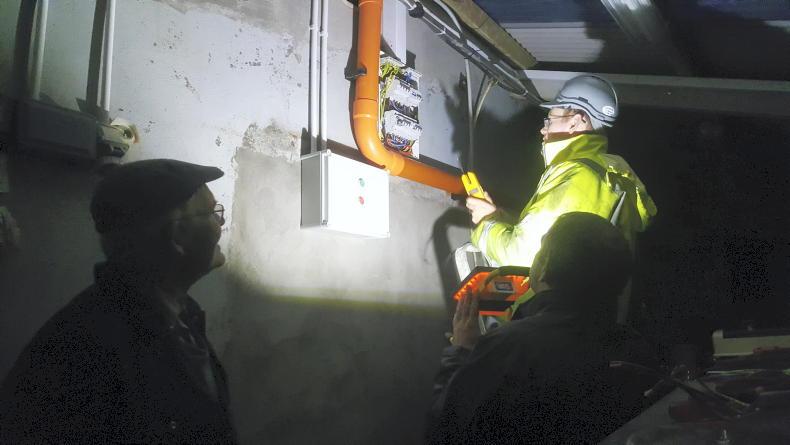A cold spell of weather with low wind speeds has the potential to cause electricity blackouts this winter as electricity demand rises in cold weather and the supply of power coming from wind decreases. While such an eventuality is not unlikely, it is unlikely to be a regular occurrence with the Government at pains to allay fears of regular blackouts.
That said, the risk of losing power, plus the increased regularity of storms and weather events, mean that many dairy farmers are either considering or have purchased backup generators recently. If the National Ploughing Championships are anything to go by, there was significant interest in generators among those in attendance.
There are two types of generators most farmers choose from. The most common type on dairy farms is the PTO-powered generator. This is connected to the tractor’s PTO output and the PTO is turned on at the 1,000 rpm speed box and the tractor is revved up until the light on the generator comes on to indicate it has reached its correct operating speed.

Bradley PTO generator at the Ploughing Championships.
Importantly, a changeover switch is required when using any type of generator to ensure any electricity produced by the generator doesn’t travel back the line where it could pose a major safety risk to ESB workers. These changeover switches are generally installed at the meter.
PTO-powered generators are either fixed or mobile. The fixed generator is bolted down while the mobile generator can be moved on a three-point linkage which is useful if the generator is being shared by a few people, or the house and farm supply are on different lines and the generator is being shared between the two places.
For those not registered for VAT, the VAT can be reclaimed for fixed generators but it cannot be reclaimed for mobile generators. There is a range of different-sized generators available and what size you buy should be determined by the load the generator will be asked to run.
For medium-sized dairy farms, a 33kVA generator is usually sufficient to comfortably power the milking parlour, bulk tank and scrapers etc. In terms of power requirement, a bulk tank is one of the most power-hungry applications on the farm when it gets turned on first so the load should take this into account.
According to Bradley PTO Generators, a 33kVA single-phase generator rated at 144 amps will cost €4,200 plus VAT. This is the same price as a 50kVA three-phase rated at 72 amps.
However, a 72 amp supply is unlikely to be sufficient if a number of large items are needed to run at the one time, such as the vacuum pump, milk cooling unit and scrapers.
For example, a vacuum pump for a 16-unit parlour will require 26 amps, the bulk tank will require 30 amps and water heaters may require 26 amps. That’s the load exceeded already before lights or scrapers are turned on.
In terms of the power requirement of the tractor running them, for single phase generators Bradleys recommend multiplying the kVA by 2.25 to get the required horsepower. In this case, a 33kVA generator will require a 75hp tractor.
Standby
A standby generator is a generator with its own power supply which is usually either a diesel- or gas-powered engine although smaller, domestic generators use petrol engines. These generators are more commonly used in industrial settings or large buildings such as hotels and hospitals that require backup power in the event of a blackout.
They come in a variety of shapes and sizes, from massive generators used to power stadia during rock concerts to smaller, farm-scale generators.

A typical farm-spec diesel stand-by generator.
These standby generators can be set up to offer a seamless backup whenever electricity goes, with just a few seconds of a delay while the engine turns on and power is generated. They can be set up to automatically run for a few hours every so often as regular use is better than being idle for prolonged periods.
In terms of costs, these are generally more expensive than PTO generators because you are buying an engine and a generator and the comfort that it will kick in as soon as power goes.
A typical farm-spec standby generator will cost in the region of €10,000 to €15,000 depending on size and specification.
An automatic transfer switch which allows the generator to kick in as soon as the mains power goes will cost over €1,000. All prices exclude VAT.
Despite the higher costs, many dairy farmers are considering diesel standby generators, particularly on larger farms where there may not be a large tractor present all the time.
A cold spell of weather with low wind speeds has the potential to cause electricity blackouts this winter as electricity demand rises in cold weather and the supply of power coming from wind decreases. While such an eventuality is not unlikely, it is unlikely to be a regular occurrence with the Government at pains to allay fears of regular blackouts.
That said, the risk of losing power, plus the increased regularity of storms and weather events, mean that many dairy farmers are either considering or have purchased backup generators recently. If the National Ploughing Championships are anything to go by, there was significant interest in generators among those in attendance.
There are two types of generators most farmers choose from. The most common type on dairy farms is the PTO-powered generator. This is connected to the tractor’s PTO output and the PTO is turned on at the 1,000 rpm speed box and the tractor is revved up until the light on the generator comes on to indicate it has reached its correct operating speed.

Bradley PTO generator at the Ploughing Championships.
Importantly, a changeover switch is required when using any type of generator to ensure any electricity produced by the generator doesn’t travel back the line where it could pose a major safety risk to ESB workers. These changeover switches are generally installed at the meter.
PTO-powered generators are either fixed or mobile. The fixed generator is bolted down while the mobile generator can be moved on a three-point linkage which is useful if the generator is being shared by a few people, or the house and farm supply are on different lines and the generator is being shared between the two places.
For those not registered for VAT, the VAT can be reclaimed for fixed generators but it cannot be reclaimed for mobile generators. There is a range of different-sized generators available and what size you buy should be determined by the load the generator will be asked to run.
For medium-sized dairy farms, a 33kVA generator is usually sufficient to comfortably power the milking parlour, bulk tank and scrapers etc. In terms of power requirement, a bulk tank is one of the most power-hungry applications on the farm when it gets turned on first so the load should take this into account.
According to Bradley PTO Generators, a 33kVA single-phase generator rated at 144 amps will cost €4,200 plus VAT. This is the same price as a 50kVA three-phase rated at 72 amps.
However, a 72 amp supply is unlikely to be sufficient if a number of large items are needed to run at the one time, such as the vacuum pump, milk cooling unit and scrapers.
For example, a vacuum pump for a 16-unit parlour will require 26 amps, the bulk tank will require 30 amps and water heaters may require 26 amps. That’s the load exceeded already before lights or scrapers are turned on.
In terms of the power requirement of the tractor running them, for single phase generators Bradleys recommend multiplying the kVA by 2.25 to get the required horsepower. In this case, a 33kVA generator will require a 75hp tractor.
Standby
A standby generator is a generator with its own power supply which is usually either a diesel- or gas-powered engine although smaller, domestic generators use petrol engines. These generators are more commonly used in industrial settings or large buildings such as hotels and hospitals that require backup power in the event of a blackout.
They come in a variety of shapes and sizes, from massive generators used to power stadia during rock concerts to smaller, farm-scale generators.

A typical farm-spec diesel stand-by generator.
These standby generators can be set up to offer a seamless backup whenever electricity goes, with just a few seconds of a delay while the engine turns on and power is generated. They can be set up to automatically run for a few hours every so often as regular use is better than being idle for prolonged periods.
In terms of costs, these are generally more expensive than PTO generators because you are buying an engine and a generator and the comfort that it will kick in as soon as power goes.
A typical farm-spec standby generator will cost in the region of €10,000 to €15,000 depending on size and specification.
An automatic transfer switch which allows the generator to kick in as soon as the mains power goes will cost over €1,000. All prices exclude VAT.
Despite the higher costs, many dairy farmers are considering diesel standby generators, particularly on larger farms where there may not be a large tractor present all the time.








 This is a subscriber-only article
This is a subscriber-only article











SHARING OPTIONS: